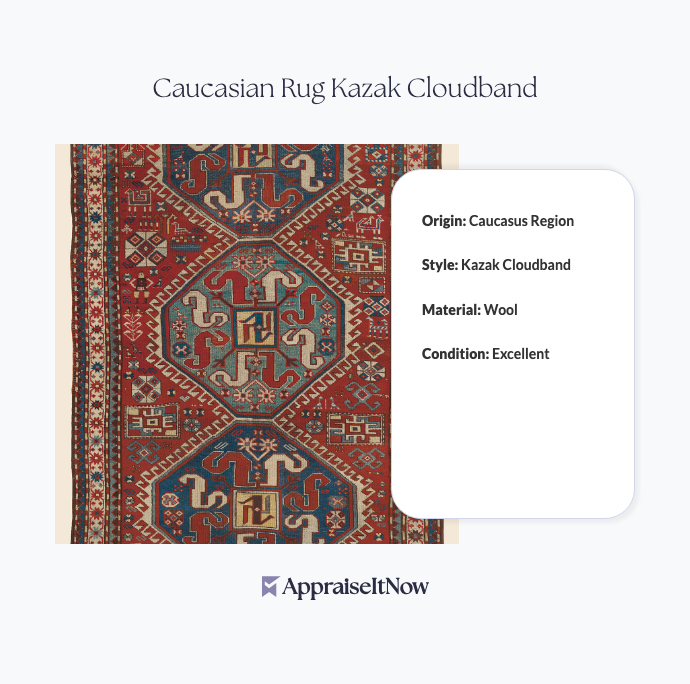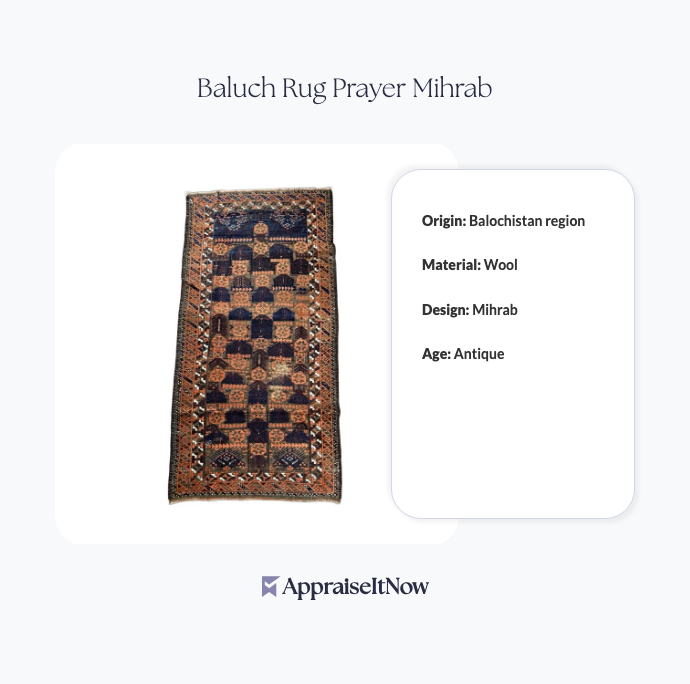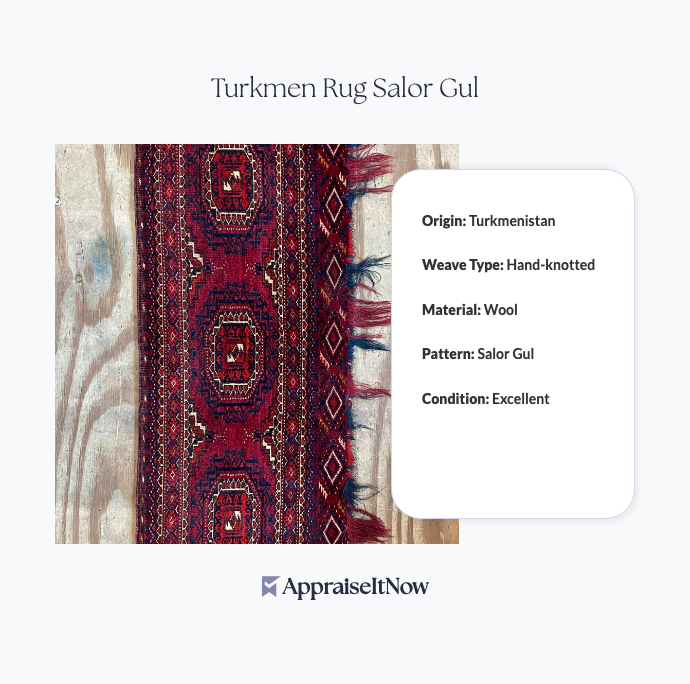<h1>How to Get Your Caucasian Shirvan Prayer Rug Appraised</h1>
<p>If you're considering selling, insuring, or donating a Caucasian Shirvan Prayer Rug, understanding its value is essential. These handwoven textiles, valued between <strong>$6,000 and $10,000</strong> for quality examples, represent significant investments in art and cultural heritage. A professional appraisal gives you the documentation and confidence needed to make informed decisions about your rug's worth.</p>
<h2>Understanding Your Caucasian Shirvan Prayer Rug's Value</h2>
<p>Caucasian Shirvan rugs stand apart as some of the most sought-after antique textiles in the collector's market. First introduced in the <strong>19th century</strong>, these rugs emerged from the Caucasus region—a mountainous area between Europe and Asia that produced textiles with distinctive character and exceptional quality. The Shirvan district specifically became renowned for rugs combining technical mastery with artistic vision, creating pieces that command attention from both collectors and institutions.</p>
<p>Your Shirvan prayer rug's value reflects several interconnected factors. The rug features a <strong>traditional prayer niche design</strong>, a central medallion surrounded by intricate geometric and floral patterns rendered in vibrant colors including red, blue, and yellow. These aren't merely decorative elements—they represent centuries of weaving tradition and cultural significance. The <strong>durable wool construction</strong> ensures longevity, meaning well-preserved examples from the 1800s remain functional art pieces rather than fragile artifacts.</p>
<p><strong>Valuation Insight:</strong> Caucasian rugs appreciate steadily in the antique market as new examples become rarer and existing pieces gain provenance documentation over time.</p>
<h2>Identifying Your Rug's Quality and Authenticity</h2>
<p>Before seeking professional appraisal, understanding what distinguishes a valuable Shirvan rug from lesser examples helps you appreciate why certified evaluation matters. Quality indicators that appraisers examine include knot density, dye authenticity, structural integrity, and design execution—each contributing to the overall assessment.</p>
<p>When evaluating whether your rug is a prayer rug, look for the distinctive niche or mihrab design that points toward Mecca in Islamic tradition. Prayer rugs feature this directional element prominently, differentiating them from other carpet types. The Shirvan style specifically combines this spiritual element with geometric precision characteristic of Caucasian weaving traditions. A high-quality Shirvan prayer rug demonstrates consistent knot work throughout, vibrant natural dyes that show appropriate aging, and patterns that maintain mathematical harmony across the entire field.</p>
<p>Is your rug vintage? Understanding the distinction between antique and vintage affects appraisal value significantly. When determining how to tell if a rug is vintage, appraisers examine construction techniques, dye chemistry, wear patterns, and materials. The oldest Shirvan prayer rugs, dating to the <strong>1800s</strong>, show specific characteristics that certified appraisers can identify, including hand-spun wool with natural variations and vegetable dyes that have aged distinctively over generations.</p>
<h2>Finding the Right Appraiser for Your Rug</h2>
<p>Locating a qualified appraiser for your Caucasian Shirvan Prayer Rug requires understanding who possesses the specialized knowledge needed. Unlike general <a href="/types/personal-property">personal property appraisals</a>, textile valuation demands expertise in regional weaving traditions, historical market trends, and authentication methods specific to antique rugs.</p>
<p>The ideal appraiser brings <strong>ISA, ASA, or CAGA credentials</strong> combined with specific experience in <a href="/types/antique-artwork">antique artwork</a> and fine textiles. These certifications indicate training in USPAP (Uniform Standards of Professional Appraisal Practice) compliance, ensuring your appraisal meets legal standards for insurance, donation, or litigation purposes. AppraiseItNow connects you with credentialed appraisers across the U.S. who specialize in <a href="/blog/appraisals-for-fine-carpets-and-rugs-valuing-artistry-beneath-your-feet">appraisals for fine carpets and rugs</a>, combining technical expertise with market knowledge specific to Caucasian textiles.</p>
<p>When selecting an appraiser, inquire about their experience with Shirvan rugs specifically. Have they appraised comparable pieces? Can they provide references from previous clients? Do they understand regional variations within Caucasian production? These questions help ensure you're working with someone whose expertise aligns with your rug's needs.</p>
<blockquote>
<p><strong>Appraiser Credentials Matter:</strong> A certified appraiser familiar with antique rugs and textiles will identify subtle quality indicators, regional characteristics, and market factors that significantly impact your rug's final valuation.</p>
</blockquote>
<h2>The Appraisal Process for Textiles</h2>
<p>Understanding what appraisers examine during a professional evaluation demystifies the process and helps you prepare appropriately. A comprehensive textile appraisal goes far beyond casual observation, employing systematic assessment of multiple value-determining factors that collectively establish fair market value.</p>
<p>Your appraiser will begin with detailed photography documenting the entire rug—front, back, corners, edges, and any areas showing wear or damage. These images become part of the permanent appraisal record and serve as invaluable documentation for insurance purposes. Next comes hands-on examination where the appraiser assesses construction quality by examining knots, assesses dye authenticity and aging patterns, and evaluates structural integrity.</p>
<p>Documentation collection forms another essential component. Your appraiser will request any provenance information—purchase receipts, previous appraisals, auction house documentation, or family history explaining how you acquired the rug. This historical information significantly impacts valuation for items like Shirvan prayer rugs, where documented lineage often increases value by 15-25% compared to pieces with unknown origins.</p>
<p>The comparison analysis follows, where appraisers examine recent comparable sales of Shirvan rugs similar to yours in age, condition, size, and quality. Current market data shows Caucasian prayer rugs averaging $6,000–$10,000 depending on these factors, but individual pieces may fall outside this range based on exceptional characteristics. A rug measuring <strong>approximately 3x5 feet</strong> with superior weaving quality and documented 19th-century origin might command the higher end of this spectrum, while a later piece in fair condition might appraise lower.</p>
<h2>Preparation Steps Before Your Appraisal</h2>
<p>Proper preparation ensures your appraisal proceeds smoothly and captures all relevant value factors. Begin by gently cleaning your rug if accumulated dust interferes with examination. Use soft brushing or, for delicate pieces, simply lay the rug flat and allow professional-grade vacuum cleaning without direct suction to the fibers.</p>
<p>Gather any documentation you possess: purchase records, auction catalogs, previous appraisals, or family narratives about the rug's acquisition and history. These materials provide context that appraisers use when researching comparable pieces and establishing provenance. If you know the rug's approximate age or origin region, share this information—appraisers can then focus investigation on Shirvan production characteristics rather than broader Caucasian traditions.</p>
<p>Ensure the rug is laid flat during appraisal so the appraiser can examine both front and back thoroughly. Back examination reveals construction details, any repairs, backing materials, or damage not visible from the decorative side. Provide clear access to corners and edges where appraisers assess selvage condition and wear patterns. The appraisal typically requires 1-3 hours depending on rug size and complexity, so allow adequate time without rushing the process.</p>
<p><strong>Preparation Advantage:</strong> Organized documentation and clean presentation of your rug demonstrates care and respect for the piece, potentially supporting higher valuations by showing proper stewardship.</p>
<h2>Special Symbols and Design Elements That Affect Value</h2>
<p>Understanding the symbolic language within your Shirvan rug's design helps you appreciate what appraisers evaluate. Do prayer rugs have special symbols? Yes—Islamic and Caucasian traditions embed spiritual and protective meanings throughout prayer rug designs. The mihrab or niche represents the direction of prayer, while geometric patterns often contain protective symbols derived from Caucasian folk traditions predating Islamic influence.</p>
<p>Shirvan rugs specifically employ geometric borders, star patterns, and stylized flora that reference natural elements important to the Caucasus region. These design choices weren't arbitrary—they reflected both spiritual significance and artistic innovation within community weaving traditions. Appraisers familiar with <a href="/blog/appraising-tribal-rugs-and-textiles-exploring-artistic-traditions-and-techniques">tribal rugs and textiles</a> recognize how design complexity, pattern rarity, and symbolic authenticity contribute to valuation.</p>
<p>The color palette itself holds significance. Natural dyes from madder root (red), indigo (blue), and various plant sources (yellows and greens) created the vibrant, warm tones characteristic of authentic Shirvan work. Modern chemical dyes produce different aging patterns and visual character. Appraisers examine dye authenticity carefully, as this factor dramatically affects both value and historical significance.</p>
<h2>Condition Assessment and Value Impact</h2>
<p>How can you tell if a rug is high quality? Beyond design and materials, condition tells the story of how a rug has been cared for through generations. Your Caucasian Shirvan Prayer Rug's condition directly impacts its appraisal value—sometimes by 30% or more compared to otherwise identical pieces in poorer condition.</p>
<p>Appraisers grade condition systematically, evaluating fiber integrity, color preservation, structural stability, and visible damage. A rug in excellent condition shows minimal wear, vibrant colors, and secure construction—commanding premium values within the $8,000–$10,000 range. Very good condition rugs show some wear consistent with age but maintain structural integrity and most original character—typically appraising at $6,000–$8,000. Fair condition pieces, showing significant wear, fading, or repairs, appraise lower but remain valuable as historically significant textiles.</p>
<p>Don't assume condition problems destroy value entirely. Appraisers understand that age brings wear—it's expected in 150-year-old textiles. What matters is whether the rug remains structurally sound and retains its essential character. A well-worn Shirvan rug from the 1800s may appraise higher than a pristine but later reproduction, as authenticity and age often outweigh perfect condition in the antique market.</p>
<blockquote>
<p><strong>Condition Context:</strong> Appraisers evaluate condition relative to the rug's age and use—a 150-year-old prayer rug showing appropriate wear may actually demonstrate authentic age and legitimate use rather than indicate diminished value.</p>
</blockquote>
<h2>Documentation for Insurance and Tax Purposes</h2>
<p>A professional appraisal report serves multiple critical functions beyond satisfying curiosity about your rug's worth. For insurance purposes, an appraisal establishes replacement cost value—the amount you'd need to restore or replace your rug if lost or damaged. Insurance companies require USPAP-compliant appraisals with detailed documentation, professional photography, and comparable market analysis supporting the valuation.</p>
<p>For <a href="/blog/charitable-donation-appraisals-guide-to-your-tax-deduction">charitable donation appraisals</a>, an independent certified appraisal determines tax deduction eligibility. IRS regulations require qualified appraisals for donations exceeding $5,000, completed by credentialed appraisers with no financial interest in the donation outcome. A well-documented Caucasian Shirvan Prayer Rug donation might generate substantial tax benefits while supporting institutions preserving cultural heritage and textile arts.</p>
<p>Estate planning similarly benefits from professional appraisal. When transferring assets to heirs or settling estates, documented appraisals prevent disputes about value and ensure fair distribution among beneficiaries. The appraisal becomes part of the permanent estate record, protecting all parties involved.</p>
<h2>Regional and Market Considerations</h2>
<p>Where are Caucasian rugs from? Understanding production geography helps appraisers contextualize your rug within broader market trends. The Caucasus region—spanning modern-day Armenia, Azerbaijan, Georgia, and surrounding areas—produced distinctive textile traditions that varied by locality. Shirvan production specifically concentrated in the eastern Caucasus, creating rugs with recognizable characteristics valued by collectors worldwide.</p>
<p>Where are Shirvan rugs made historically? The same Shirvan district continues some traditional production, though antique 19th-century examples command significantly higher values than contemporary pieces using traditional methods. This distinction matters for appraisals—your rug's origin date and original production context directly affect valuation within the broader market.</p>
<p>Current market trends show steady appreciation for authenticated antique Caucasian textiles. Museums, serious collectors, and institutions increasingly recognize cultural value in these pieces, supporting stable-to-strong demand. Appraisers monitor auction results from Christie's, Sotheby's, and specialized textile auction houses to ensure valuations reflect current market conditions. A Shirvan prayer rug appraised at $8,000 five years ago might legitimately appraise higher today as the market for antique Caucasian textiles has appreciated.</p>
<h2>Understanding Appraisal Report Content</h2>
<p>When you receive your formal appraisal from AppraiseItNow or another qualified appraiser, expect a comprehensive document containing specific sections supporting the valuation. The report opens with identification information—dimensions (your rug measures approximately <strong>3x5 feet</strong>), estimated age, origin, and material composition (handwoven wool construction).</p>
<p>The detailed description section covers design elements, color palette, condition observations, and any notable features or damage. Professional photography accompanies this section, providing visual documentation of the appraisal's basis. The appraisal then presents comparable market analysis—examples of similar Shirvan rugs that sold recently, explaining how each comparable supported the final valuation.</p>
<p>Most critically, the appraisal concludes with the certified value statement, articulating fair market value, replacement cost value (for insurance), and any limiting conditions affecting the appraisal's scope. This final section makes the document suitable for insurance claims, tax documentation, or sale purposes—providing the professional certification that distinguishes appraisals from casual estimates.</p>
<p><strong>Report Quality Matters:</strong> A thorough appraisal report becomes invaluable documentation for insurance claims, tax filings, or future sales—investing in quality appraisal work protects your interests across multiple scenarios.</p>
<h2>Why Professional Appraisal Matters for Caucasian Rugs</h2>
<p>Your Caucasian Shirvan Prayer Rug represents more than a floor covering—it embodies centuries of cultural tradition, artistic skill, and historical narrative. Yet without professional appraisal, this value remains invisible and undocumented. Many rug owners discover, only when appraised, that their inherited or acquired piece commands substantially more value than they realized.</p>
<p>Professional appraisal transforms your rug from an assumed-value item into a properly documented asset. Whether you're buying, selling, insuring, or donating, the certified appraisal stands as authoritative documentation that protects your interests and reflects the rug's genuine market position. The investment in professional appraisal typically represents just 1-2% of your rug's value—modest insurance against undervaluation or disputed worth.</p>
<p>Understanding the factors that affect value—from age and authenticity to condition and provenance—helps you recognize why professional expertise matters. When you're ready to move forward with evaluation of your Shirvan prayer rug, seeking appraisers trained through recognized organizations like the AAA, ISA, ASA, or CAGA ensures you receive expert analysis backed by professional standards.</p>
<blockquote>
<p><strong>Key Takeaway:</strong> A certified appraisal of your Caucasian Shirvan Prayer Rug provides essential documentation for insurance, taxation, and sale purposes while establishing the true market value of this culturally significant antique textile. Professional appraisers with expertise in <a href="/blog/appraising-fine-textiles-valuing-antique-fabrics-and-weavings">fine textiles and antique artwork</a> ensure your rug receives the expert evaluation it deserves.</p>
</blockquote>







.avif)







